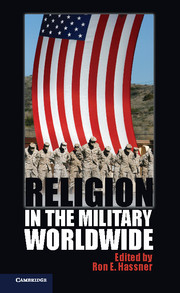Book contents
1 - Japan
Published online by Cambridge University Press: 05 June 2014
Summary
Introduction: (Ir)religious? The Japanese Self-Defense Force’s Relationship with Religion
Scholars have written much about the relationship between the postwar Japanese state and religion, but they have given little attention to interactions between the military and religion. As an organ of the state, Japan’s Self-Defense Force (SDF) is expected to adhere to the same constitutional and legal rules as other government bodies. The two most relevant provisions regarding the role of religion in the SDF are Articles 20 and 89. Article 20 guarantees “freedom of religion” and prohibits the state from engaging in the following activities: supporting a particular religion; compelling citizens to take “part in any religious acts, celebration, rite, or practice”; and engaging in “any other religious activity.” Likewise, Article 89 stipulates that “no public money or other property shall be expended or appropriated for the use, benefit, or maintenance of any religious institution or association.” Based on these constitutional provisions, and according to the organization’s official policies, the SDF is required to respect the religious freedom of its personnel and not to engage in or support any religious practices.
Japan is a highly secularized society that possesses a vibrant and multifaceted religious culture. According to public opinion polls, around two-thirds of Japanese do not believe in a god or gods and do not profess a particular religious faith. Of those who do identify with a particular religion (less than a third of Japanese society), approximately 20 percent are Buddhist, nearly 6 percent are Shinto, and around 1 percent are Christian. These statistics confirm that Japan is one of the most thoroughly secularized countries in the world. Nevertheless, religious practices occupy a prominent place in the lives of many Japanese, even among those who do not consider themselves religious. A significant number of Japanese take a syncretic approach to religion; in other words, as a famous saying puts it, many people are “born Shinto, die Buddhist,” get married in a Christian church, and engage in a variety of disparate religious practices over the course of their lives.
- Type
- Chapter
- Information
- Religion in the Military Worldwide , pp. 23 - 44Publisher: Cambridge University PressPrint publication year: 2013
References
- 1
- Cited by



